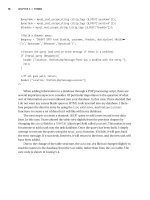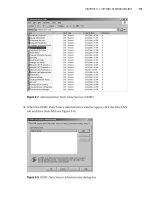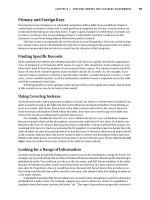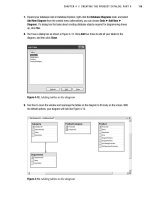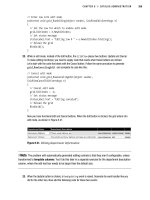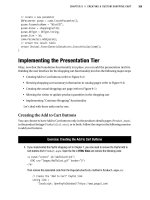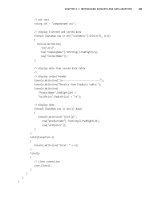Beginning Hibernate From Novice to Professional phần 5 docx
Bạn đang xem bản rút gọn của tài liệu. Xem và tải ngay bản đầy đủ của tài liệu tại đây (339.27 KB, 35 trang )
L
isting 6-18 shows a fairly typical application of the
@
JoinTable
a
nnotation to specify the
name of the join table and its foreign keys into the associated entities.
Listing 6-18. A Unidirectional One-to-Many Association with a More Fully Specified Join Table
@OneToMany(cascade = ALL)
@JoinTable(
name="PublishedBooks",
joinColumns = { @JoinColumn( name = "publisher_id") },
inverseJoinColumns = @JoinColumn( name = "book_id")
)
public Set<Book> getBooks() {
return books;
}
Mapping a Many-to-Many Association
When a many-to-many association does not involve a first-class entity joining the two sides
of the relationship, a link table must be used to maintain the relationship. This can be gen-
erated automatically, or the details can be established in much the same way as with the
link table described in the “Mapping a Many-to-One or One-to-Many Association” section
of the chapter.
The appropriate annotation is naturally
@ManyToMany, and takes the following attributes:
mappedBy is the field that owns the relationship—this is only required if the association is
bidirectional. If an entity provides this attribute, then the other end of the association is
the owner of the association, and the attribute must name a field or property of that entity.
targetEntity is the entity class that is the target of the association. Again, this may be
inferred from the generic or array declaration, and only needs to be specified if this is not
possible.
cascade indicates the cascade behavior of the association, which defaults to none.
fetch indicates the fetch behavior of the association, which defaults to LAZY.
The example maintains a many-to-many association between the
Book class and the
Author class. The Book entity owns the association, so its getAuthors() method must be
mar
ked with an appropriate
@ManyToMany attr
ibute, as shown in Listing 6-19.
Listing 6-19. The B
ook Side of the Many-to-Many Association
@ManyToMany(cascade = ALL)
public Set<Author> getAuthors() {
return authors;
}
The Author entity is managed by the Book entity. The link table is not explicitly managed,
so, as shown in Listing 6-20, we mark it with a
@ManyToMany annotation and indicate that the
foreign key is managed b
y the
authors attr
ibute of the associated
Book entity
.
CHAPTER 6 ■ MAPPING WITH ANNOTATIONS 119
6935ch06_final.qxd 8/2/06 9:47 PM Page 119
Listing 6-20. The Author Side of the Many-to-Many Association
@ManyToMany(mappedBy = "authors")
public Set<Book> getBooks() {
return books;
}
Alternatively, we could specify the link table in full, as in Listing 6-21.
Listing 6-21. Specifying the Link Table in Full Using the Book Entity Annotations
@ManyToMany(cascade = ALL)
@JoinTable(
name="Books_to_Author",
joinColumns={@JoinColumn(name="book_ident")},
inverseJoinColumns={@JoinColumn(name="author_ident")}
)
public Set<Author> getAuthors() {
return authors;
}
Inheritance
The EJB 3 standard and Hibernate both support three approaches to mapping inheritance
hierarchies into the database. These are as follows:
• Single table (
SINGLE_TABLE)
• Joined (
JOINED)
• Table-per-class (
TABLE_PER_CLASS)
Persistent entities that are related by inheritance must be marked up with the
@Inheritance annotation. This takes a single strategy attribute, which is set to one of three
javax.persistence.InheritanceType enumeration values corresponding to these approaches
(shown in brackets in the preceding bulleted list).
The single table approach manages one class for the superclass and all its subtypes.
There are columns for each mapped field or property of the superclass, and for each dis-
tinct field or property of the derived types. When following this strategy, you will need to
ensure that columns are appropriately renamed when any field or property names collide
in the hierarchy.
To determine the appropriate type to instantiate when retrieving entities from the data-
base, an
@DiscriminatorColumn annotation should be provided in the root (and only in the
root) of the persistent hierarchy.
3
This defines a column containing a value that distinguishes
betw
een each of the types used. The attributes permitted by the
@DiscriminatorColumn anno
-
tation are as follows:
CHAPTER 6 ■ MAPPING WITH ANNOTATIONS120
3. That is to say, the highest class in the hierarchy that is mapped to the database as an entity should be
annotated in this way
.
6935ch06_final.qxd 8/2/06 9:47 PM Page 120
n
ame
i
s the name of the discriminator column.
discriminatorType is the type of value to be stored in the column as selected from the
javax.persistence.DiscriminatorType enumeration of STRING, CHAR, or INTEGER.
c
olumnDefinition
i
s a fragment of DDL defining the column type. Using this is liable
to reduce the portability of your code across databases.
length is the column length of STRING discriminator types. It is ignored for CHAR and
INTEGER types.
All of these (and the annotation itself) are optional, but we recommend supplying at least
the
name attribute. If no @DiscriminatorColumn is specified in the hierarchy, a default column
name of
DTYPE and type of STRING will be used.
Hibernate will supply an appropriate discriminator value for each of your entities. For
example, if the
STRING discriminator type is used, the value this column contains will be the
name of the entity (which defaults to the class name). You can also override this behavior with
specific values using the
@DiscriminatorValue annotation. If the discriminator type is INTEGER,
any value provided via the
@DiscriminatorValue annotation must be convertible directly into
an integer.
In Listing 6-22, we specify that an
INTEGER discriminator type should be stored in the
column named
DISCRIMINATOR. Rows representing Book entities will have a value of 1 in
this column, whereas the following mapping in Listing 6-23 requires that rows represent-
ing
ComputerBook entities should have a value of 2 in the same column.
Listing 6-22. The Root of the Inheritance Hierarchy Mapped with the SINGLE_TABLE Strategy
@Entity
@Inheritance(strategy = SINGLE_TABLE)
@DiscriminatorColumn(
name="DISCRIMINATOR",
discriminatorType=INTEGER
)
@DiscriminatorValue("1")
public class Book {
}
Listing 6-23. A Derived Entity in the Inheritance Hierarchy
@Entity
@DiscriminatorValue("2")
public class ComputerBook extends Book {
}
An alter
nativ
e to the monolithic single table appr
oach is the otherwise similar joined
table approach. Here a discriminator column is used, but the fields of the various derived
types are stored in distinct tables. Other than the differing strategy, this inheritance type is
specified in the same way (as sho
wn in Listing 6-24).
CHAPTER 6 ■ MAPPING WITH ANNOTATIONS 121
6935ch06_final.qxd 8/2/06 9:47 PM Page 121
L
isting 6-24.
T
he Root of the Inheritance Hierarchy Mapped with the
J
OINED
S
trategy
@
Entity
@Inheritance(strategy = JOINED)
@DiscriminatorColumn(
n
ame="DISCRIMINATOR"
)
public class Book {
}
Finally, there is the table-per-class approach, in which all of the fields of each type in the
inheritance hierarchy are stored in distinct tables. Because of the close correspondence between
the entity and its table, the
@DiscriminatorColumn annotation is not applicable to this inheri-
tance strategy. Listing 6-25 shows how our
Book class could be mapped in this way.
Listing 6-25. The Root of the Inheritance Hierarchy Mapped with the TABLE_PER_CLASS Strategy
@Entity
@Inheritance(strategy = TABLE_PER_CLASS)
public class Book {
}
Other EJB 3 Persistence Annotations
Although we have now covered most of the core EJB 3 persistence annotations, there are a few
others that you will encounter fairly frequently. We cover some of these in passing in the fol-
lowing sections.
Temporal Data
Fields or properties of an entity that have java.util.Date or java.util.Calendar types repre-
sent temporal data. By default, these will be stored in a column with the
TIMESTAMP data type,
but this default behavior can be overridden with the
@Temporal annotation.
The annotation accepts a single
value attribute from the javax.persistence.
TemporalType
enumeration. This offers three possible values: DATE, TIME, and TIMESTAMP.
These corr
espond r
espectiv
ely to
java.sql.Date, java.sql.Time, and java.sql.Timestamp.
The table column is given the appropriate data type at schema generation time. Listing 6-26
shows an example mapping a
java.util.Date property as a TIME type—the java.sql.Date
and java.sql.Time classes are both der
iv
ed from the
java.util.Date class, so confusingly
,
both are capable of representing dates
and times!
Listing 6-26. A Date Property Mapped as a Time Temporal Field
@Temporal(TIME)
public java.util.Date getStartingTime() {
return this.startingTime;
}
CHAPTER 6 ■ MAPPING WITH ANNOTATIONS122
6935ch06_final.qxd 8/2/06 9:47 PM Page 122
Large Objects
A persistent property or field can be marked for persistence as a database-supported large
object type by applying the
@Lob annotation.
The annotation takes no attributes, but the underlying large object type to be used will
be inferred from the type of the field or parameter. String- and character-based types will be
stored in an appropriate character-based type. All other objects will be stored in a BLOB.
Listing 6-27 maps a
String into a large object column type.
Listing 6-27. An Example of a Large Object Property
@Lob
public String getTitle() {
return this.title;
}
The @Lob annotation can be used in combination with the @Basic annotation.
Mapped Superclasses
A special case of inheritance occurs when the root of the hierarchy is not itself a persistent
entity, but various classes derived from it are. Such a class can be abstract or concrete. The
@MappedSuperclass annotation allows you to take advantage of this circumstance.
The class marked with
@MappedSuperclass is not an entity, and is not queryable (it cannot
be passed to methods that expect an entity in the
Session or EntityManager objects). It can-
not be the target of an association.
The mapping information for the columns of the superclass will be stored in the same
table as the details of the derived class (in this way, the annotation resembles the use of the
an
@Inheritance tag with the SINGLE_TABLE strategy).
In other respects, the superclass can be mapped as a normal entity, but the mappings will
apply to the derived classes only (since the superclass itself does not have an associated table
in the database). When a derived class needs to deviate from the superclass’s behavior, the
@AttributeOverride annotation can be used (much as with the use of an embeddable entity).
For example, if in our example model
Book was a superclass of ComputerBook, but Book
objects themselves were never persisted directly, then Book could be marked as
@MappedSuperclass, as in Listing 6-28.
Listing 6-28. M
arking the
Book Class A
s a Mapped Superclass
@Entity
@MappedSuperclass
public class Book {
}
The fields of the ComputerBook entity derived from Book would then be stored in the
ComputerBook entity class’s table. Classes derived directly from Book but not mapped as entities
in their own right, such as a hypothetical
MarketingBook class, would not be persistable. In this
respect alone, the mapped superclass approach behaves differently from the conventional
@Inheritance approach with a SINGLE_TABLE strategy.
CHAPTER 6 ■ MAPPING WITH ANNOTATIONS 123
6935ch06_final.qxd 8/2/06 9:47 PM Page 123
Named Queries (HQL or EJB QL)
@NamedQuery and @NamedQueries allow one or more EJB QL queries to be associated with an
entity. The required attributes are as follows:
name is the name by which the query is retrieved.
query is the EJB QL (or HQL) query associated with the name.
Listing 6-29 shows an example associating a named query with the
Author entity. The
query would retrieve
Author entities by name, so it is natural to associate it with that entity—
however, there is no actual requirement that a named query be associated in this way with the
entity that it concerns.
Listing 6-29. An EJB QL Named Query Annotation
@Entity
@NamedQuery(
name="findAuthorsByName",
query="from Author where name = :author"
)
public class Author {
}
There is also a hints attribute, taking a QueryHint annotation name/value pair, which
allows caching mode, timeout value, and a variety of other platform-specific tweaks to be
applied (this can also be used to comment the SQL generated by the query).
You do not need to directly associate the query with the entity against which it is declared,
but it is normal to do so. If a query has no natural association with any of the entity declara-
tions, it is possible to make the
@NamedQuery annotation at the package level.
There is no natural place to put a package-level annotation, so Java annotations allow for
a specific file, called
package-info.java, to contain them. Listing 6-30 gives an example of this.
Listing 6-30. A package-info.java File
@javax.annotations.NamedQuery(
name="findAuthorsByName",
query="from Author where name = :author"
)
package com.hibernatebook.annotations;
Hibernate’s session allows named queries to be accessed directly, as shown in Listing 6-31.
Listing 6-31. Invoking a Named Query via the Session
Query query = session.getNamedQuery("findAuthorsByName");
query.setParameter("author", "Dave");
List booksByDave = query.list();
System.out.println("There is/are " + booksByDave.size()
+ " author(s) called Dave in the catalog");
CHAPTER 6 ■ MAPPING WITH ANNOTATIONS124
6935ch06_final.qxd 8/2/06 9:47 PM Page 124
I
f you have multiple
@
NamedQuery
a
nnotations to apply to an entity, they can be provided
as an array of values of the
@NamedQueries annotation.
Named Native Queries (SQL)
EJB 3 also allows the database’s native query language (usually a dialect of SQL) to be used in
place of EJB QL. You risk losing portability here if you use a database-specific feature, but as
long as you use reasonably generic SQL, you should be OK. The
@NamedNativeQuery annotation
is declared in almost exactly the same manner as the
@NamedQuery annotation. The following
block of code shows a simple example of the use of a named native query.
@NamedNativeQuery(
name="nativeFindAuthorNames",
query="select name from author"
)
Multiple @NamedNativeQuery annotations can be grouped with the @NamedNativeQueries
annotation.
■Note Hibernate does not currently fully support named native queries.
Configuring the Annotated Classes
Once you have an annotated class, you will need to provide the class to your application’s
Hibernate configuration, just as if it were an XML mapping. With annotations, you can use
either the declarative configuration in the
hibernate.cfg.xml XML configuration document,
or you can programmatically add annotated classes to Hibernate’s
org.hibernate.cfg.
AnnotationConfiguration
object. Your application may use both annotated entities and
XML mapped entities in the same configuration.
To provide declarative mapping, we use a normal
hibernate.cfg.xml XML configuration
file and add the annotated classes to the mapping using the
mapping element (see Listing 6-32).
Notice that we have specified the name of the annotated class as a mapping.
Listing 6-32. A Hibernate XML Configuration File with an Annotated Class
<?xml version='1.0' encoding='utf-8'?>
<!DOCTYPE hibernate-configuration PUBLIC
"-//Hibernate/Hibernate Configuration DTD//EN"
" /><hibernate-configuration>
<session-factory>
<property name="connection.driver_class">
org.hsqldb.jdbcDriver
</property>
CHAPTER 6 ■ MAPPING WITH ANNOTATIONS 125
6935ch06_final.qxd 8/2/06 9:47 PM Page 125
<
property name="connection.url">
jdbc:hsqldb:file:annotationsdb;shutdown=true
</property>
<
property name="connection.username">sa</property>
<property name="connection.password"></property>
<property name="hibernate.connection.pool_size">0</property>
<property name="show_sql">false</property>
<property name="dialect">
org.hibernate.dialect.HSQLDialect
</property>
<! Mapping files >
<mapping class="com.hibernatebook.annotations.Author"/>
<mapping class="com.hibernatebook.annotations.AuthorAddress"/>
<mapping class="com.hibernatebook.annotations.Book"/>
<mapping class="com.hibernatebook.annotations.Address"/>
<mapping class="com.hibernatebook.annotations.Publisher"/>
<mapping class="com.hibernatebook.annotations.ComputerBook"/>
</session-factory>
</hibernate-configuration>
You can also add an annotated class to your Hibernate configuration programmatically.
The annotations toolset comes with an
org.hibernate.cfg.AnnotationConfiguration object
that extends the base Hibernate
Configuration object for adding mappings. The methods on
AnnotationConfiguration for adding annotated classes to the configuration are as follows:
addAnnotatedClass(Class persistentClass) throws MappingException
addAnnotatedClasses(List<Class> classes)
addPackage(String packageName) throws MappingException
Using these methods, you can add one annotated class, a list of annotated classes, or an
entire package (by name) of annotated classes. As with the Hibernate XML configuration file,
the annotated entities are interoperable with XML mapped entities.
Hibernate 3–Specific Persistence Annotations
T
able 6-2 lists
the Hibernate-specific annotations. We will now look at some of these Hibernate-
specific annotations in more detail—however, bear in mind that using any of this functionality
potentially reduces the portability of your application to other EJB 3 solutions.
Annotations that are not recognized by an EJB 3 environment will be ignored, rather than
causing a runtime ex
ception directly—however, this may result in different runtime applica-
tion behavior that may not be desirable. I
n some cases
, H
ibernate 3 annotations can be used
to prepare resources that are referenced by standard EJB 3 annotations, in which case the
application will fail when the EJB 3 envir
onment attempts to use the missing r
esource.
CHAPTER 6 ■ MAPPING WITH ANNOTATIONS126
6935ch06_final.qxd 8/2/06 9:47 PM Page 126
■Tip It is possible to overstate the importance of portability—most bespoke applications are never
deployed to an environment other than the one for which they were originally developed. As a mature prod-
uct, Hibernate 3 has numerous features to offer above and beyond the base EJB 3 specification. You should
not waste too much time trying to achieve a portable solution in preference to these proprietary features
unless you have a definite requirement for portability.
Table 6-2. The Hibernate Annotations
Attribute Name Target Purpose
AccessType T, M, and F Allows the default access type (normally deter-
mined by the placement of the
@javax.
persistence.Id
annotation) for the annotated
object to be overridden.
BatchSize T, M, and F Allows the batch size for a query to be specified.
Cache T, M, and F Allows a cache concurrency strategy (NONE,
NONSTRICT_READ_WRITE, READ_ONLY, READ_WRITE, or
TRANSACTIONAL) to be selected.
Cascade M and F Applies a Hibernate-specific cascade strategy to an
association.
Check T, M, and F Allows an arbitrary SQL constraint to be specified
during the schema generation.
CollectionOfElements M and F Allows a collection field or an attribute to be
marked as a collection of elements or embedded
objects, rather than a full-fledged association with
an entity.
Columns M and F Allows an array of @javax.persistence.Column
annotations to be applied to an annotated
Hibernate composite user type.
DiscriminatorFormula T Allows the discriminator type to be determined
with an HQL formula instead of the default EJB 3
mechanisms.
Entity T
Allo
ws Hibernate-specific attributes to be applied
in addition to the
javax.persistence.Entity anno-
tation information.
Filter/Filters T, M, and F Adds named filters to an entity or a collection.
FilterDef/FilterDefs Pk and T Allows named filters to be declared.
Formula MF
Allo
ws an SQL for
mula to be
used in place of v
alues
drawn from a column.
GenericGenerator Pk,
T, M, and F Allows a Hibernate-specific generator to be used
when creating a primary key value for the entity.
Index M and F Allows a database index to be defined for a column
or columns.
IndexColumn M and F
Allo
ws a
collection to maintain an or
der on the
basis of an index column maintaining the element
or
der
ing (i.e., collection ordering rather than data-
base or
dering).
Continued
CHAPTER 6 ■ MAPPING WITH ANNOTATIONS 127
6935ch06_final.qxd 8/2/06 9:47 PM Page 127
Table 6-2. Continued
Attribute Name Target Purpose
NamedNativeQuery/ Pk and T Extends the corresponding EJB 3 named native
NamedNativeQueries query functionality with various Hibernate-specific
query hints.
NamedQuery/NamedQueries Pk and T Extends the corresponding EJB 3 named query
functionality with various Hibernate-specific query
hints.
NotFound M and F Allows the behavior to be defined for circumstances
in which an expected entity is missing. The options
drawn from the
NotFoundAction enumeration are
the self-explanatory
EXCEPTION and IGNORE values.
The default is
EXCEPTION.
OnDelete T, M, and F Allows Hibernate-specific behavior on deletion of
collections, arrays, and joined subclasses.
OrderBy M and F Allows a collection to be ordered by SQL rather than
HQL (as with the EJB 3 annotation) ordering.
ParamDef Pm Used to define parameters for Filter annotations.
Parameter Pm Used to declare parameters for GenericGenerator
annotations.
Proxy T Allows the proxy behavior for an entity to be config-
ured or disabled.
Sort M and F Allows a collection to be sorted using a comparator.
Table/Tables T Allows indexes to be applied to a table (see the
“Applying Indexes with
@Table and @Index” section
later in the chapter).
Type M and F Marks a field or an attribute as being a composite
user type.
TypeDef/TypeDefs Pk and T Allows a composite user type to be defined.
Where T, M, and F Applies a Where clause to an entity or association.
Key to the Target column: Pk = package, T = type,M = method, F = field, Pm = parameter
All the annotations and
enumerations described here fall into the
org.hibernate.
annotations
package. When we refer to an EJB 3 annotation or enumeration, we will use
the fully qualified
javax.persistence.* class name.
@E
ntity
The Hibernate-specific @Entity annotation extends the basic details of the @javax.
persistence.Entity
annotation, but is other
wise used in the same contexts. It allows the
following additional attributes to be specified:
dynamicInsert is used to flag
that inser
t statements should be generated at run time (not
at star
tup), allo
wing only the alter
ed columns to be inser
ted. B
y default this is disabled.
dynamicUpdate is used to flag
that update statements should be gener
ated at r
un time,
allowing only the altered columns to be updated. By default this is disabled.
CHAPTER 6 ■ MAPPING WITH ANNOTATIONS128
6935ch06_final.qxd 8/2/06 9:47 PM Page 128
m
utable
i
s
t
rue
b
y default, but if set to
f
alse
,
it allows the persistence engine to cache the
values read from the database, and the persistence engine will make no attempt to update
them in response to changes (changes that should not be made if this flag is set to
false).
optimisticLock allows an optimistic lock strategy to be selected from the
O
ptimisticLockType
e
numeration values of
A
LL
, D
IRTY
, N
ONE
,
and
V
ERSION
.
This defaults
to
VERSION.
persister allows a persister class other than the default Hibernate one to be selected for
the entity (for example, allowing serialization to be used instead of relational persistence).
polymorphism allows the polymorphism strategy to be selected from the PolymorphismType
enumeration values of EXPLICIT and IMPLICIT. This defaults to IMPLICIT.
selectBeforeUpdate allows the user to request that a SELECT be performed to retrieve the
entity before any potential update.
Sorting Collections with @Sort
The Hibernate-specific @Sort annotation allows a collection managed by Hibernate to be
sorted by a standard Java comparator. The following code gives an example.
@javac.persistence.OneToMany
@org.hibernate.annotations.Sort(
type=org.hibernate.annotations.SortType.COMPARATOR,
comparator=EmployeeComparator.class
)
public Set<Employee> getEmployees() {
return this.employees;
}
Ordering Collections with @IndexColumn
While @Sort allows data to be sorted once it has been retrieved from the database, Hibernate
also provides a non-standard persistence feature that allows the ordering of appropriate col-
lection types such as
List to be maintained within the database by maintaining an index
column to represent that order. Here’s an example:
@javax.persistence.OneToMany
@org.hibernate.annotations.IndexColumn(
name="employeeNumber"
)
public List<Employee> getEmployees() {
return this.employees;
}
Here, we are declaring that an employeeNumber column will maintain a value, starting at 0
and incrementing as each entry is added to the list. The default starting value can be overridden
by the
base attribute. By default, the column can contain null (unordered) values. This can be
overridden by setting the
nullable attribute to false. By default, when the schema is generated
CHAPTER 6 ■ MAPPING WITH ANNOTATIONS 129
6935ch06_final.qxd 8/2/06 9:47 PM Page 129
f
rom the annotations, the column is assumed to be an
i
nteger
t
ype, but this can be overridden
by supplying a
columnDefinition attribute specifying a different column definition string.
Applying Indexes with @Table and @Index
The Hibernate-specific @Table annotation supplements the standard table annotation and
allows additional index hints to be provided to Hibernate. These will be used at schema gener-
ation time to apply indexes to the columns specified. The following code gives an example.
// Standard persistence annotations:
@javax.persistence.Entity
@javax.persistence.Table(name="FOO")
// Hibernate-specific table annotation:
@Table(
appliesTo="FOO", indexes = {
@Index(name="FOO_FROM_TO_IDX",columnNames={"FIRST","LAST"}),
@Index(name="FOO_EMPLOYEE_IDX",columnNames={"EMPLOYEE_NUM"}))
public class Foo {
}
Restricting Collections with @Where
The contents of a collection that will be retrieved from the database can be restricted with
a Hibernate-specific
@Where annotation. This simply adds a Where clause to the query that
will be used to obtain the entities contained within the collection. Here’s an example:
@javax.persistence.OneToMany
@org.hibernate.annotations.Where(clause="grade > 2")
public Set<Employee> getEmployees() {
return this.employees;
}
Alternative Key Generation Strategies with @GenericGenerator
As mentioned in the “
P
r
imary Keys with
@Id and @GeneratedValue” section, the full gamut of
Hibernate primary key value generators is not supported by the standard set of annotations.
Hibernate therefore supplies the
@GenericGenerator annotation to fill the void.
The attributes that can be supplied to the annotation ar
e as follo
ws:
name is mandator
y, and is used to identify the generic generator in the
@GeneratedValue
annotation.
strategy is mandator
y
, and determines the generator type to be used. This can be a stan-
dar
d H
iber
nate gener
ator type or the name of a class implementing the
org.hibernate.
id.IdentifierGenerator
inter
face
.
parameters is a list of @Parameter annotations defining any parameter values required by
the generator strategy.
CHAPTER 6 ■ MAPPING WITH ANNOTATIONS130
6935ch06_final.qxd 8/2/06 9:47 PM Page 130
T
he available standard Hibernate strategies are
i
ncrement
, i
dentity
, s
equence
, h
ilo
,
seqhilo, uuid, guid, native, assigned, select, and foreign. For example, the non-standard
uuid strategy for a primary key is configured as follows:
@Id
@
GenericGenerator(name="unique_id",strategy="uuid")
@GeneratedValue(generator="unique_id")
public String getId() {
return this.id;
}
Alternatively, to configure the sequence strategy (equivalent to specifying a strategy of
SEQUENCE in the @GeneratedValue annotation), you can supply the following parameters:
@Id
@GenericGenerator(name="seq_id",strategy="sequence",
parameters= {
@Parameter(name="sequence",value="HIB_SEQ")
}
)
@GeneratedValue(generator="seq_id")
public Integer getId() {
return this.id;
}
Using Ant with Annotation-Based Mappings
When using the Hibernate Ant tasks in conjunction with the annotation-based mappings,
you operate under one important constraint: the Ant task cannot read the mapping infor-
mation from the raw source files. The annotated files must be compiled before you can
perform any operations on them (including schema generation). You should therefore
ensure that any Hibernate Ant tasks are granted a dependency upon the compile task for
the entities.
The Ant task will also need access to the classes via the configuration object—you will
therefore need to explicitly include any annotated classes in the
hibernate.cfg.xml file as
described in the first part of the previous “Configuring the Annotated Classes” section. You
cannot use programmatic configuration of the classes in conjunction with tasks such as
hbm2ddl, so this is an impor
tant step
.
The various Hibernate JAR files, including
hibernate-annotations.jar, will need to be in
the classpath of the task definition.
Finally, you will need to specify an
<annotationconfiguration /> element, rather than
the usual
<configuration /> element. An example Ant target to build a DDL scr
ipt from
annotated classes is shown in Listing 6-33.
CHAPTER 6 ■ MAPPING WITH ANNOTATIONS 131
6935ch06_final.qxd 8/2/06 9:47 PM Page 131
Listing 6-33. A Sample Excerpt from this Chapter’s Task to Perform Schema Generation
<
target name="exportDDL" depends="compile">
<mkdir dir="${sql}"/>
<htools destdir="${sql}">
<
classpath refid="classpath.tools"/>
<annotationconfiguration
configurationfile="${src}/hibernate.cfg.xml"/>
<hbm2ddl
create="true"
drop="true"
format="true"
export="true"
outputfilename="${ant.project.name}.dll"/>
</htools>
</target>
A full Ant script is provided with the online source code for this chapter (at www.apress.com).
Code Listings
Listings 6-34 and 6-35 contain the completed annotated source code for the Author and Book
classes described in this chapter. The database schema also follows in Listing 6-36.
Listing 6-34 illustrates use of the
@Entity, @Inheritance, @Id, @GeneratedValue, @Column,
@Transient, @ManyToOne, @JoinColumn, and @ManyToMany annotations.
Listing 6-34. The Fully Annotated Book Class
package com.hibernatebook.annotations;
import static javax.persistence.CascadeType.ALL;
import static javax.persistence.InheritanceType.JOINED;
import java.util.*;
import javax.persistence.*;
@Entity
@Inheritance(strategy = JOINED)
public class Book {
private String title;
private Publisher publisher;
private Set<Author> authors = new HashSet<Author>();
private int pages;
private int id;
protected Date publicationDate;
CHAPTER 6 ■ MAPPING WITH ANNOTATIONS132
6935ch06_final.qxd 8/2/06 9:47 PM Page 132
/
/ Constructors
protected Book() {
}
public Book(String title, int pages) {
this.title = title;
this.pages = pages;
}
// Getters
@Id
@GeneratedValue
public int getId() {
return id;
}
@Column(name = "working_title", length = 200, nullable = false)
public String getTitle() {
return title;
}
public int getPages() {
return pages;
}
@Transient
public Date getPublicationDate() {
return publicationDate;
}
@ManyToOne
@JoinColumn(name = "publisher_id")
public Publisher getPublisher() {
return publisher;
}
@ManyToMany(cascade = ALL)
public Set<Author> getAuthors() {
return authors;
}
// Setters
CHAPTER 6 ■ MAPPING WITH ANNOTATIONS 133
6935ch06_final.qxd 8/2/06 9:47 PM Page 133
p
ublic void setId(int id) {
this.id = id;
}
public void setTitle(String title) {
this.title = title;
}
public void setPages(int pages) {
this.pages = pages;
}
public void setPublicationDate(Date publicationDate) {
this.publicationDate = publicationDate;
}
public void setPublisher(Publisher publisher) {
this.publisher = publisher;
}
public void setAuthors(Set<Author> authors) {
this.authors = authors;
}
// Helpers
public void addAuthor(Author author) {
authors.add(author);
}
}
Listing 6-35 demonstrates the use of the @NamedQuery, @Embedded, @AttributeOverrides,
and
@AttributeOverride annotations.
Listing 6-35. The Fully Annotated Author Class
package com.hibernatebook.annotations;
import java.util.HashSet;
import java.util.Set;
import javax.persistence.*;
@Entity
@NamedQuery(
name="findAuthorsByName",
query="from Author where name = :author"
)
public class Author {
CHAPTER 6 ■ MAPPING WITH ANNOTATIONS134
6935ch06_final.qxd 8/2/06 9:47 PM Page 134
p
rivate int id;
private String name;
private Set<Book> books = new HashSet<Book>();
p
rivate AuthorAddress address;
// Constructors
protected Author() {
}
public Author(String name, AuthorAddress address) {
this.name = name;
this.address = address;
}
// Getters
@Id
@GeneratedValue
public int getId() {
return id;
}
public String getName() {
return name;
}
@ManyToMany(mappedBy = "authors")
public Set<Book> getBooks() {
return books;
}
@Embedded
@AttributeOverrides({
@AttributeOverride(name="address",column=@Column(name="ADDR")),
@AttributeOverride(name="country",column=@Column(name="NATION"))
})
public AuthorAddress getAddress() {
return this.address;
}
// Setters
public void setId(int id) {
this.id = id;
}
CHAPTER 6 ■ MAPPING WITH ANNOTATIONS 135
6935ch06_final.qxd 8/2/06 9:47 PM Page 135
p
ublic void setName(String name) {
this.name = name;
}
public void setBooks(Set<Book> books) {
this.books = books;
}
public void setAddress(AuthorAddress address) {
this.address = address;
}
}
Finally, Listing 6-36 shows the database schema for the classes supporting this chapter,
as generated by the Ant
hbm2ddl export task for the HSQL database. You will note that we are
unable to control the names selected for the foreign key relationships. This is one area in
which the Hibernate XML mapping files are superior to the EJB 3 annotations.
Listing 6-36. The Database Schema for the Example
create table Address (
id integer not null,
city varchar(255),
country varchar(255),
primary key (id)
);
create table Author (
id integer generated by default as identity (start with 1),
ADDR varchar(255),
NATION varchar(255),
name varchar(255),
primary key (id)
);
create table Book (
id integer generated by default as identity (start with 1),
pages integer not null,
working_title varchar(200) not null,
publisher_id integer,
primary key (id)
);
create table Book_Author (
books_id integer not null,
authors_id integer not null,
primary key (books_id, authors_id)
);
CHAPTER 6 ■ MAPPING WITH ANNOTATIONS136
6935ch06_final.qxd 8/2/06 9:47 PM Page 136
c
reate table ComputerBook (
BOOK_ID integer not null,
softwareName varchar(255),
p
rimary key (BOOK_ID)
);
create table Publisher (
id integer generated by default as identity (start with 1),
name varchar(255),
address_id integer,
primary key (id)
);
alter table Book
add constraint FK1FAF0990BF1C70
foreign key (publisher_id)
references Publisher;
alter table Book_Author
add constraint FK1A9A0FA1B629DD87
foreign key (authors_id)
references Author;
alter table Book_Author
add constraint FK1A9A0FA1D3BA8BC3
foreign key (books_id)
references Book;
alter table ComputerBook
add constraint FK98D97CC4600B1724
foreign key (BOOK_ID)
references Book;
alter table Publisher
add constraint FKCDB7C1DC158ECEF0
foreign key (address_id)
references Address;
Summary
I
n this chapter
, w
e used EJB 3
annotations to add metadata to our POJOs for H
ibernate, and
we looked at the Hibernate-specific annotations that can enhance these at the cost of reduced
por
tability.
In the next chapter
, w
e discuss the alter
nativ
e approach of using XML mapping docu-
ments to expr
ess the mapping r
equir
ements
.
CHAPTER 6 ■ MAPPING WITH ANNOTATIONS 137
6935ch06_final.qxd 8/2/06 9:47 PM Page 137
6935ch06_final.qxd 8/2/06 9:47 PM Page 138
Creating Mappings with
Hibernate XML Files
In the simple example programs in Chapters 1 and 3, we demonstrated how a mapping file
could be used to establish the relationship between the object model and the database
schema. A mapping file can map a single class or multiple classes to the database. The map-
ping can also describe standard queries (in HQL and SQL) and filters.
Hibernate Types
Although we have referred to the Hibernate types in passing, we have not discussed the ter-
minology in any depth. In order to express the behavior of the mapping file elements, we
need to make these fine distinctions explicit.
Hibernate types fall into three broad categories: entities, components, and values.
Entities
Generally, an entity is a POJO class that has been mapped into the database using the <class>
or <subclass> elements.
An entity can also be a dynamic map (actually a
Map of Maps). These are mapped against
the database in the same way as a POJO, but with the default entity mode of the
SessionFactory set to dynamic-map.
The advantage of POJOs over the
dynamic-map approach is that compile-time type safety
is retained. Conversely, dynamic maps are a quick way to get up and running when building
pr
ototypes.
It is also possible to represent your entities as Dom4J
Document objects. This is a useful
feature when importing and exporting data from a preexisting Hibernate database, but it is
not r
eally central to the ev
eryday use of Hibernate.
We recommend that you use the standard entity mode unless you need to sacrifice accu-
racy for timeliness, so the alternate approaches are not discussed in this chapter—however,
w
e giv
e some simple examples of the Dom4J- and
Map-based mappings in A
ppendix A.
139
CHAPTER 7
■ ■ ■
6935ch07_final.qxd 8/2/06 9:43 PM Page 139
Components
Lying somewhere between entities and values are component types. When the class represen-
tation is simple and its instances have a strong one-to-one relationship with instances of
a
nother class, then it is a good candidate to become a component of that other class.
The component will normally be mapped as columns in the same table that represents
most of the other attributes of the owning class, so the strength of the relationship must justify
this inclusion. In the following code, the
MacAddress class might a good candidate for a com-
ponent relationship.
public class NetworkInterface {
public int id;
public String name;
public String manufacturer;
public MacAddress physicalAddress;
}
The advantage of this approach is that it allows you to dispense with the primary key of
the component and the join to its containing table. If a poor choice of component is made
(for example, when a many-to-one relationship actually holds), then data will be duplicated
unnecessarily in the component columns.
Values
Everything that is not an entity or a component is a value. Generally, these correspond to the
data types supported by your database, the collection types, and, optionally, some user-
defined types.
The details of these mappings will be vendor-specific, so Hibernate provides its own value
type names; the Java types are defined in terms of these (see Table 7-1).
Table 7-1. The Standard Hibernate 3 Value Names
Hibernate 3 Type Corresponding Java Type
Primitives and Wrappers
integer int, java.lang.Integer
long long, java.lang.Long
short short, java.lang.Short
float float, java.lang.Float
double
double, java.lang.Double
character char, java.lang.Character
byte byte, java.lang.Byte
boolean, yes_no, true_false boolean, java.lang.Boolean
O
ther Classes
string
java.lang.String
date, time, timestamp java.util.Date
calendar, calendar_date
java.util.Calendar
CHAPTER 7 ■ CREATING MAPPINGS WITH HIBERNATE XML FILES140
6935ch07_final.qxd 8/2/06 9:43 PM Page 140
Hibernate 3 Type Corresponding Java Type
b
ig_decimal java.math.BigDecimal
big_integer java.math.BigInteger
locale java.util.Locale
timezone java.util.TimeZone
currency java.util.Currency
class java.lang.Class
binary byte[]
text java.lang.String
serializable java.io.Serializable
clob java.sql.Clob
blob java.sql.Blob
In addition to these standard types, you can create your own. Your user type class should
implement either the
org.hibernate.usertype.UserType interface or the org.hibernate.
usertype.CompositeUserType
interface. Once implemented, a custom type can behave iden-
tically to the standard types; though depending on your requirements, it may be necessary to
specify multiple column names to contain its values, or to provide initialization parameters
for your implementation.
For one-off cases, we recommend that you use components—these have similar behavior,
but they can be “created” in the mapping file without needing to write Hibernate-specific
code. Unless you propose to make substantial use of a custom type throughout your applica-
tion, it will not be worth the effort. We do not discuss this feature further in this book.
The Anatomy of a Mapping File
A mapping file is a normal XML file. It is validated against a DTD, which can be downloaded
from
You can also look
through the annotated version at
.
The terminology used in the naming of elements and attributes is somewhat confusing at
first because it is the point of contact between the jargon of the object-oriented and relational
worlds.
The <hibernate-mapping> Element
The root element of any mapping file is <hibernate-mapping>. As the top-level element, its
attributes mostly define default behaviors and settings to apply to the child elements (see
Table 7-2).
CHAPTER 7 ■ CREATING MAPPINGS WITH HIBERNATE XML FILES 141
6935ch07_final.qxd 8/2/06 9:43 PM Page 141
T
able 7-2.
T
he
<
hibernate-mapping>
A
ttributes
Attribute Values Default Description
auto-import true, false true By default, allows you to use the unqualified
class names in Hibernate queries. You would
normally only set this to
false if the class
name would otherwise be ambiguous.
catalog The database catalog against which queries
should apply.
default-access property The default access type. If set to property, then
get and set methods are used to access the
data. If set to
field, then the data is accessed
directly. Alternatively, you can provide the
class name of a
PropertyAccessor implementa-
tion defining any other access mechanism.
default-cascade Defines how (and whether) direct changes to
data should affect dependent data by default.
default-lazy true, false true Defines whether lazy instantiation is used by
default. Generally, the performance benefits
are such that you will want to use lazy instanti-
ation whenever possible.
package The package from which all implicit imports
are considered to occur.
schema The database schema against which queries
should apply.
The default cascade modes available for the default-cascade attribute (and for the cas-
cade attributes in all other elements) are as follows:
create, merge, delete, save-update, evict, replicate, lock, refresh
These correspond to the various possible changes in the lifestyle of the parent object.
When set (you can include combinations of them as comma-separated values), the relevant
changes to the parent will be cascaded to the relation. For example, you may want to apply
the save-update cascade option to a class that includes Set attributes, so that when new per-
sistent classes are added to these, they will not have to be saved explicitly in the session.
There are also three special options:
all, delete-orphan, none
all
specifies that all changes to the parent should be propagated to the relation, and none
specifies that none should. delete-orphan applies only to one-to-many associations, and speci-
fies that the r
elation should be deleted when it is no longer referenced by the parent.
The required order and cardinality of the child elements of
<hibernate-mapping> are as
follows:
(meta*,
typedef*,
import*,
(class | subclass | joined-subclass | union-subclass)*,
(query | sql-query)*,
filter-def*)
CHAPTER 7 ■ CREATING MAPPINGS WITH HIBERNATE XML FILES142
6935ch07_final.qxd 8/2/06 9:43 PM Page 142
Throughout this book, we have assumed that the mappings are defined in one mapping
file for each significant class that is to be mapped to the database. We suggest that you follow
this practice in general, but there are some exceptions to this rule. You may, for instance, find
it useful to place
query and sql-query entries into an independent mapping file, particularly
when they do not fall clearly into the context of a single class.
The <class> Element
The child element that you will use most often—indeed, in nearly all of your mapping files—is
<class>. As you have seen in earlier chapters, we generally describe the relationships between
Java objects and database entities in the body of the
<class> element. The <class> element
permits the following attributes to be defined (see Table 7-3).
T
able 7-3.
The <class> A
ttributes
Attribute Values Default Description
abstract true, false false The flag that should be set if the class being
mapped is abstract.
batch-size
1
S
pecifies the
number of items that can be
batched together when retrieving instances of
the class b
y identifier
.
catalog The database catalog
against which the
queries should apply.
Continued
CHAPTER 7 ■ CREATING MAPPINGS WITH HIBERNATE XML FILES 143
THE ORDER AND CARDINALITY INFORMATION FROM THE DTD
The mapping files used by Hibernate have a great many elements and are somewhat self-referential. For
example, the
<component> element permits you to include within it further <component> elements, and
within those further
<component> elements—and so on, ad infinitum.
While we do not quote exhaustively from the mapping file’s DTD, we sometimes quote the part of it
that specifies the permitted ordering and cardinality (number of occurrences) of the child elements of a
given element.
The cardinality is expressed by a symbol after the end of the name of the element:
* means “zero
or more occurrences,”
? means “zero or one occurrences,” and no trailing symbol means “exactly one
occurrence.”
The elements can be grouped using brackets, and where the elements are interchangeable,
| (the pipe
symbol) means “or.”
In practical terms, this allows us to tell from the order and cardinality information quoted for the
hibernate-mapping file that all of the elements immediately below it are, in fact, optional. We can also
see that there is no limit to the number of
<class> elements that can be included.
You can look up this ordering and cardinality information in the DTD for the mapping file for all the
elements, including the ones that we have omitted from this chapter. You will also find within the DTD the
specification of which attributes are permitted to each element, the values they may take (when they are
constrained), and their default values when provided. We recommend that you look at the DTD for enlight-
enment whenever you are trying to work out whether a specific mapping file should be syntactically valid.
6935ch07_final.qxd 8/2/06 9:43 PM Page 143


